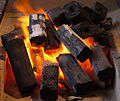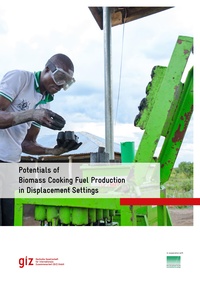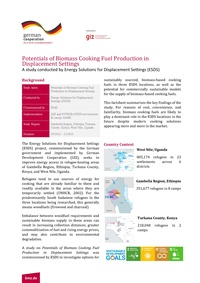Knowledge fuels change - Support energypedia!
For over 10 years, energypedia has been connecting energy experts around the world — helping them share knowledge, learn from each other, and accelerate the global energy transition.
Today, we ask for your support to keep this platform free and accessible to all.
Even a small contribution makes a big difference! If just 10–20% of our 60,000+ monthly visitors donated the equivalent of a cup of coffee — €5 — Energypedia would be fully funded for a whole year.
Is the knowledge you’ve gained through Energypedia this year worth €5 or more?
Your donation keeps the platform running, helps us create new knowledge products, and contributes directly to achieving SDG 7.
Thank you for your support, your donation, big or small, truly matters!
Potentials of Biomass Cooking Fuel Production in Displacement Settings
Overview
The Energy Solutions for Displacement Settings (ESDS) project, commissioned by the German government and implemented by German Development Cooperation (GIZ), seeks to improve energy access in refugee-hosting areas of Gambella Region, Ethiopia; Turkana County, Kenya; and West Nile, Uganda. Imbalance between woodfuel requirements and sustainable biomass supply in these areas can result in increasing collection distances, greater commoditisation of fuel and rising energy prices. It may also contribute to environmental degradation. ESDS commissioned a study to identify the most viable options for increasing access to safe, reliable and sustainable biomass cooking fuel for refugees and hosts; and to develop business models and implementation approaches for the selected solutions. The study was carried out by a team from INTEGRATION environment and energy GmbH, a Germany-based consulting company.
Country Context
Fuel supply to refugees in the ESDS locations is dominated by locally sourced firewood and charcoal. In West Nile and Gambella, most firewood is self-collected at little or no cost, so willingness to pay for alternatives is likely to be low. In Kakuma, the fuel economy is largely monetised. This offers more potential for market-based alternatives since people are already paying for their fuel. For alternative fuels to be adopted, however, price and performance needs to compete closely with existing low-cost options. Across all three sites, most refugees have limited purchasing power and woodfuels will continue to dominate cooking energy supply.
There have been various initiatives to promote non-woodfuel sources of energy for cooking over the decades in which refugees have been hosted in these regions, none of which have been able to compete on cost and quality with charcoal or firewood. The challenge has been to ensure reliable supply of good quality fuel at a competitive price, relative to woodfuels, after introductory funding for alternatives has been phased out.
{{#display_map: 7.960541944365048, 34.193791640101146~Gambella Region, Ethiopia; 3.3451273645833357, 35.45052723944797~Turkana County, Kenya; 3.0003389825101654, 31.60951854782345~Westnile, Uganda;
|service=openlayers |zoom=5 }}
Firewood, Charcoal and Alternatives
Through a multi-criteria shortlisting process, firewood and charcoal were identified as the most viable biomass-based fuels for cooking in the three locations. Fuel briquettes manufactured from carbonised biomass (char) showed the most promise as a biomass-based alternative to firewood and charcoal, out of 21 fuels considered. Other biomass-based options such as pellets, ethanol and non-carbonised briquettes were assessed as less realistic for reasons of cost, availability or user acceptability. Solutions based on fossil fuels and electricity were deemed out of scope for the assignment.
Char briquettes have been widely produced in East Africa and private firms have penetrated niche markets outside the humanitarian sector, primarily for commercial and industrial use. Their experiences indicate that briquettes should be mass produced in mechanised operations to achieve reliable output, consistent quality and economies of scale. A compelling price/performance offering is required to incentivise a shift away from charcoal, the next most affordable option. Manufacturing briquettes for household cooking has not been a viable business proposition, however, with most producers reliant on grants and unable to sustain sales to the domestic cooking market.
| The top-ranked fuel in the assessment was charcoal, which is an energy-dense, adaptable and popular fuel that is readily available in local markets. | 
|
| Charcoal was followed by firewood, Africa’s most widely used fuel due to its availability, access, cost, familiarity and suitability for a variety of diets and cooking traditions. | 
|
Ranked below woodfuels were two types of briquette:
|

|

| |
| Electric cooking using a self-contained solar PV system was considered out of scope as it is not biomass-based. Cooking using renewables-based electricity is a an interesting prospect and there has been promising research in Uganda by the Modern Energy Cooking Services programme and by INTEGRATION environment and energy GmbH. | 
|
| Pellets scored relatively poorly due to lack of supply, user unfamiliarity and a requirement for custom-built stoves with induced air supply. Pelletised fuels and stoves in the humanitarian context received a major setback with the collapse of the Inyenyeri operation in Rwanda in 2020, which paired pellets with Mimi Moto gasifier stoves. | 
|
| LPG also scored poorly against the chosen criteria, as it is not biomass-based, requires a costly new stove and provides no local livelihood benefits. LPG remains an aspirational option for urban households. | 
|
| Non-carbonised briquettes ranked close to the bottom in this analysis. These fuels are made from loose biomass such as sawdust or crop processing residues (husks, shells, stalks). They have been promoted in both the Uganda and Ethiopia refugee programmes, fabricated both at artisanal facilities with hand-operated equipment and at semi-industrial facilities. There has been no demonstrated commercial uptake due to performance limitations and high cost. | 
|
| Ethanol scored lowest in the analysis, and has a patchy and unsatisfactory history in the region’s refugee operations. A long-term pilot by the Gaia Foundation in Ethiopia ended due to cost and supply chain constraints for both the fuel and stoves, and an SNV-managed pilot in Kakuma was terminated after less than one year due to similar supply chain constraints. |
Business Model
To determine the cost of production for a commercial briquetting operation, a customisable business model was developed to simulate the mass production of char briquettes for refugee operations. The model reveals that the selling price for char briquettes in the refugee locations would need to be almost double the prevailing price of charcoal, the next cheapest alternative, for the business to be viable. To promote such fuel would require subsidy of around $3.2m in the first year to meet the needs of 10% of refugees across the three locations, and upwards of $3m per annum thereafter.
Conclusion
For reasons of cost, convenience and familiarity, woodfuels will remain the dominant source of cooking energy in the ESDS locations. Continued support is therefore required for measures to improve the sustainability of woodfuel supply and maximise the efficiency with which it is used. Alternative energy sources may also become part of the solution, with char briquettes the most viable of the biomass-based options available. But analysis for this study has shown that the production and promotion of such briquettes would require large subsidy over an indefinite period, which could be more effectively invested elsewhere. There would also be significant market development challenges.
Recommendations
A package of measures is proposed to address woodfuel supply/demand imbalances and energy access challenges in the ESDS locations, as summarised in the table below:
 Westnile, Uganda
Westnile, Uganda
- Reducing woodfuel consumption: Support ‘last mile’ marketing, sales and distribution to get higher tier charcoal cookstoves into the refugee settlements, building on existing support to ‘energy kiosks’.
- Enhancing sustainable supply of biomass: Promote higher biomass yields from natural forests, private plantations and homestead planting through interventions in (agro-) forestry and improvements in wood processing (e.g. carbonisation).
- Promoting alternative fuels: Conduct a wider cost-benefit comparison of cooking options, including electricity, to fully evaluate investment and subsidy levels, infrastructure challenges and long-term health, social, economic and environmental benefits.
 Gambella, Ethiopia
Gambella, Ethiopia
- Reducing woodfuel consumption: Support the user-centric design and local manufacture of simple clay stoves for refugee use, which can make an affordable and appropriate contribution to easing the fuel sourcing burden on refugee families.
- Enhancing sustainable supply of biomass: Promote conservation-friendly agriculture and agroforestry on farms and around homesteads, and support the protection of natural forests. Research the impacts of refugees on forest resources, similar to those by FAO in W. Nile and Kakuma.
- Promoting alternative fuels: Consider the procurement of firewood from sustainable sources for groups identified as vulnerable.
 Turkana, Kenya
Turkana, Kenya
- Reducing woodfuel consumption: Strengthen and sustain the promotion of improved cookstoves through EnDev’s SNV-managed Market-Based Energy Access programme.
- Enhancing sustainable supply of biomass: Improve efficiencies in the Prosopis value chain (including better charcoal production), establish and protected ‘greenbelts’ and plant drought-resistant tree species in micro-catchments.
- Promoting alternative fuels: Conduct a wider cost-benefit comparison of cooking options to evaluate investment and subsidy levels, infrastructure challenges and long-term health, social, economic and environmental benefits.
In addition to the above measures, a cross-cutting package of measures to provide a supportive enabling environment for sustainable cooking fuel solutions is recommended. This should include cross-sectoral coordination, donor engagement, host/refugee working groups, the development of decentralised policies on renewable energy and natural resource management, policy advocacy to tackle unhelpful regulatory barriers and a programme of targeted research. The long term goal should be to move to electricity for cooking, with effective trials of new technologies to help the transition.
Further Readings
- Why cooking fuels are a protection issue
- User-Centered Design in Humanitarian Energy Projects
- Webinar on Cooking Energy in Displacement Settings
- Cooking Energy Matrix - overview of all cooking fuels and technologies
Partners
GIZ's Energy Solutions for Displacement Settings (ESDS) project cooperate with UNHCR to enhance the access to sustainable energy in displacement contexts, and the Energypedia page has been created to share learnings across various practitioners to spur the development of clean energy solutions.






















